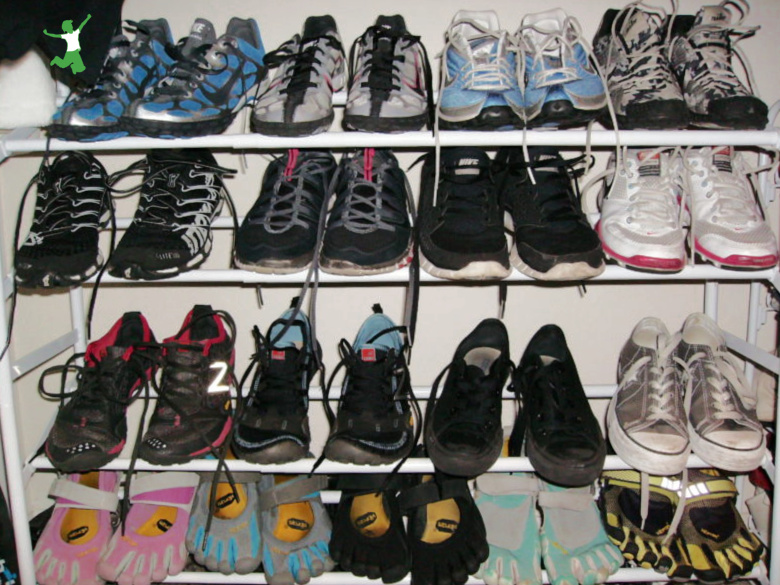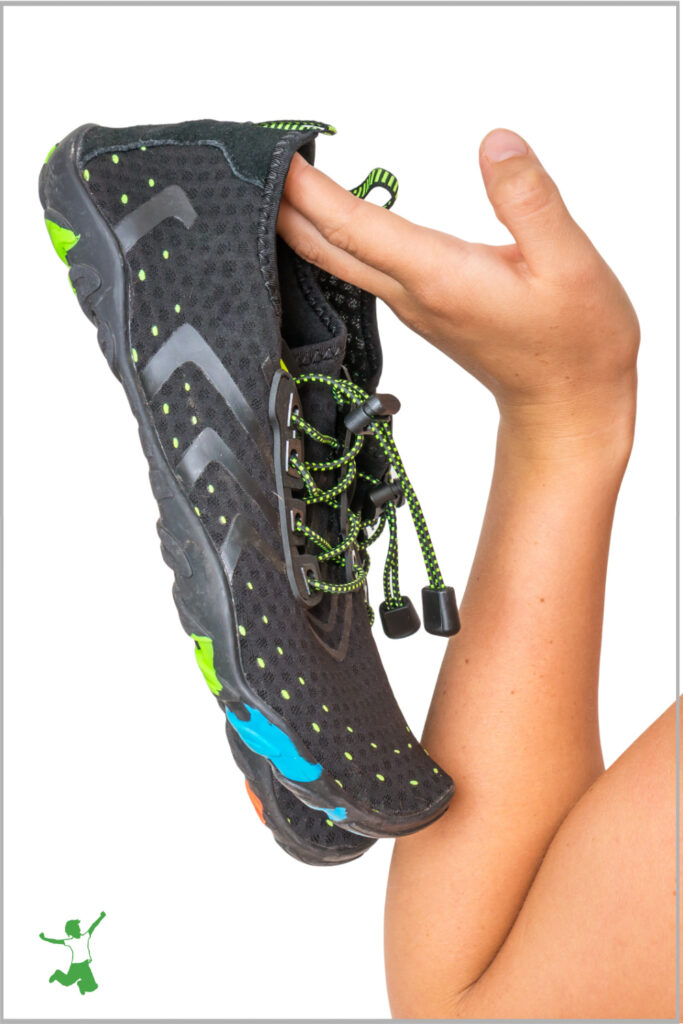Table of Contents[Hide][Show]
Why going barefoot as much as possible maintains foot health for optimal structural integrity and reduces inflammation in the tendons, bones, and joints.

Go against nature. That is what modern man seems to do best.
Plain and simple–take a look around and observe what happens when we do.
Fake egg whites dyed yellow in cartons, powdered milk and proteins along with refined vegetable oils will do much to ruin your health.
Add to that list man-made foot crutches; bound up artificial materials, elevated softened heel support, padded inserts, padded cushions, arch supports, insoles, and orthotics. Go ahead–spend some time in big clunky shoes and see what happens to your body over the long run–no pun intended.
We were born barefoot to continuously ground with Mother Earth and built to run.
The massive amount of free electrons from earthing via the soles of our feet is the most powerful anti-inflammatory known to science, in fact!
And man has been walking and running that way for eons until the recent onslaught of platform sneakers in the late seventies.
Now I don’t suggest that you show up for work Monday morning wearing nothing but your five bare toes, but walking, running and just wearing shoes with artificial support, in general, will wreak havoc on your feet, ankles, knees, hips, and lower back.
The cumulative damage will most likely cause grave orthopedic concerns.
But “what?”, you say “I have flat feet!” I don’t doubt it and I’ll bet they are also weak with atrophied muscles. A small percentage of the populace is actually born that way but for most of us, it is developed.
{Editor’s note: flat feet can also indicate poor and undeveloped bone structure caused by a lack of the fat-soluble vitamins A, D, and K2 while in the womb as researched by Dr. Weston A. Price early in the last century}.
Reasons to go barefoot. . .
There are several very important reasons to go barefoot as much as possible for your health. These include:
- The big fat cushiony heel support found in modern-day running shoes goes against our natural gait and can result in a shortened Achilles tendon and calf muscle.
- It takes more energy to run with the extra weight of the shoes.
- Worst of all, they are designed to make you land with your heel while we are designed (by nature) to land on our forefoot. The repetitive strain of slamming on your heel results in undue shock and potential joint injury. By landing on the ball or forefoot with light steps allows our arch to act as the natural spring that it is.
- By wearing all that fake support our muscles, tendons, and ligaments have weakened. And that’s not only the ones found in our feet bus also in our hips and legs. This will also decrease coordination, agility, and balance.
Start Slow!
So what should you do if you want to try opting into the barefoot trend?
First and foremost, go slow and avoid the goal of logging long distances every week. Contrary to popular belief, training for and running a marathon is not healthy.
When I was first introduced to this concept I immediately did a 360 and threw out all 16 pairs of my Nikes and other clunky shoes.
I bought a pair of Vibram Five Fingers and started running. I was almost 50 at the time, did not run much, had poor running form, was inefficient in my efforts, and had some orthopedic concerns.
I first ran 800 m in them, not very far. My entire lower legs and feet were so sore I could barely walk for 5 days.
I continued however and tried to gradually build up the running but kept encountering the debilitating discomfort in my lower legs and feet.
Quite simply, they had gone soft and weak and were not yet ready for that type of endurance. Yet I continued and tore my left calf, a grade 1 strain that took about 6 weeks to heal (once I finally laid off).
Maybe they were wrong and I needed the support? No, I did not believe that–it made too much sense. Everything I researched everything concluded we were indeed meant to run barefoot or with a shoe that simulated that offering minimal to no support.
After the calf healed I started wearing them on a daily basis, usually about 12+ hours a day–analogous to simply going barefoot. My feet and lower legs still got a workout but I could walk fine with no discomfort.
After about a month of doing that for I began running short distances 2x a week and alternating every third day with a minimalist shoe like a Nike Free for longer runs that offered less support than the clunkers but more than the Vibrams.
I continued that route and eventually weaned myself off them and recently ran the 11.5 mile Tough Mudder in my Vibrams. Excellent shoes for trail running.
What I have noticed from a personal level is improved running efficiency, improved coordination, balance, agility and an overall sense of being more grounded. I have had 2 surgeries on my right knee and running and certain activities often aggravated it, but not anymore.
The occasional discomfort I would feel in my knee has disappeared.
In retrospect, I would say that the cumulative damage from walking, running and playing sports in improper footwear probably greatly contributed to the damage I sustained in my knee.
Sadly, I see children playing and running in improper footwear taking away from their natural ability to squat, run and jump which will likely lead to problems later in life.
If you are an efficient runner, perhaps younger or with little to no orthopedic concerns you should do fine with them. Convert slowly, testing the waters and increase usage wisely. Most of my clients have converted to running “barefoot” with little to no problems.
Some of my favorites as seen in the picture include Vibram Five Fingers, Inov8 195 & 180, and New Balance Trail Minimus. More and more barefoot footwear is hitting the market daily.
Do your feet and body a favor and throw out your clunkers because even though the shoe “fits” doesn’t mean you should wear it.
Editor’s Note: To learn more about the benefits of going barefoot and contacting the energy of the Earth directly, be sure to check out the acclaimed book Earthing, by Martin Zucker.









Would these shoes work for running on concrete? It seems like our feet were not designed for the types of surfaced we are usually walking on in modern society and it does seem like it could be damaging to our feet to run barefoot on concrete. Any thoughts? What types of surfaces do most of you run on?
Hey Paula! I read this article @ the library, while wearing my Vibrams (the original style; I’m a purist). I love, love, LOVE my Vibrams! I can say that everything Paula said held true for me, also. You are ABSOLUTELY going to be VERY sore around the lower half of your calf if you don’t run barefoot regularly. But after you’ve adapted to them, there’s nothing more fun then running, working out, or even shopping in these little guys!
Very interesting article.
You talk about running in these shoes. I stand for hours on end at work, would these shoes help at all with that? My feet don’t like me much after a full day of work and that causes me not to want to do any exercise :-/
I usually wear them for about 12 to 14 hours a day; activities are a combo of working out (less than an hour), sitting and long periods of standing. Much improved overall after ditching the platform sneakers. I would recommend some type of mobility work in addition if you are on your feet all day.
I am not a runner, but I do like walking for exercise. Are these shoes recommended for walking and regular daily activity?
Why wouldn’t they be?
The Vibram, and other minimalist shoes, offer minimal protection from the elements, while letting your feet feel free. If you can walk barefoot around your house, you can walk in Vibrams outside. You might get some weird/curious looks, but that’s just part of the experience.
That would be the ideal.
Ooops, wrong place for that comment.
But yes, they are excellent for walking and everyday activity. I like to match them to my outfits:)
I have been walking around an indoor track in my socks since it is winter outside now, but I am looking forward to walking and then slowly working up to running barefoot/minimalist. I am a runner and I have suffered with plantar fasciitis for 20 years. I am really hoping to strengthen up my feet and enjoy some pain free running in time.
I have been walking around an indoor track in my socks since it is winter outside now, but I am looking forward to walking and then slowly working up to running barefoot/minimalist. I am a runner and I have suffered with plantar fasciitis for 20 years. I am really hoping to strengthen up my feet and enjoy some pain free running in time.
Have you checked out Katy Bowman’s new book, “Every Woman’s Guide to Foot Pain Relief?” It’s amazing and addresses all these issues.
I teach all my classes in minimalist shoes and i am starting a lunch time running club from my studio in UK. I think the mantra is slowly does it your feet do get lazy in hard shoes so just like any person new to activity you need build up foot strength slowly. But your feet have as much sensitivity as your lips tongue hands, and we put ear muffs on our feet. My feet need to tell the rest of my body what is going on from ground reaction. Viva bare feet
I’m not sure if it would work for Vibrams, but I have found that a cobbler is a great resource for making mainstream shoes more minimalist and grounding friendly. (We still go barefoot 90% of the time around here)